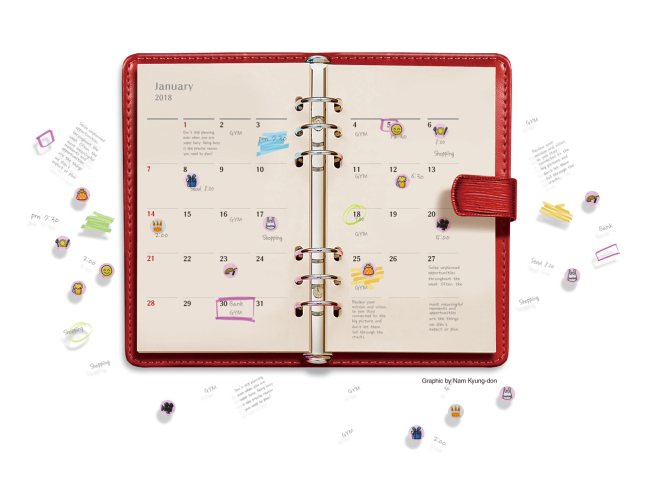[Weekender] Dear diary: Koreans’ undying love of putting pen to paper
From the diary decoration trend to the emergence of 'bullet journals,' analog diaries still matter
By Park Ju-youngPublished : Jan. 5, 2018 - 16:47
What comes to your mind when you think of the term “diary?” For some, the word means a journal to write down reflections on the day. For others, the term covers a broader range of books: planners, schedulers, calendars -- even blank notes could be called a diary if people can log their days on them.
Despite the surge of interest in digital scheduling applications and journals, the popularity of paper diaries seems undiminished in Korea.
Despite the surge of interest in digital scheduling applications and journals, the popularity of paper diaries seems undiminished in Korea.

The craze for the diaries is strongest toward the end of the year. More than 40 stationery companies churn out hundreds of different types and designs. Coffee chains dole out diaries as year-end promotional gifts and bookstores install special corners to showcase planners.
Over the past few years, diary sales have increased in some distribution segments. According to stationery store “10x10,” diaries recorded 25 percent sales growth in 2017, and the momentum is likely to continue.
Why do Koreans still stick to old-fashioned diaries?
“Of course, it would be easier to keep a daily log if I used a digital application,” Instagram user “December” told The Korea Herald. “But I still use my analog diary, as I can fill the blank sheet whatever way I want. I love that feeling, writing the memories and records of the day with my hand.”
Every night, she sits on a chair and opens her diary. With her favored pen (Uni-ball Style Fit 0.28 mm), she writes down her daily log. Then, she goes to her desk drawer, packed with color pens, patterned tapes and fancy stickers, and fills the blanks with colors that reflect her mood that day.
The 40-minute ritual ends when she completes the final task -- taking a picture of the diary and posting it on her Instagram account. She has uploaded 259 posts so far, and over 7,000 people have hit the follow button to subscribe to her daily updates.
December is not the only one who enthusiastically spends time and effort on beautifully crafting the pages.
At last count, there are over 400,000 posts with #diary hashtags in Korean on Instagram. If searching with the hashtag #decoratingdiary, hundreds of pictures pop up, showing off the Instagram users’ decorating skills.
Decorating styles could differ from person to person, but most diary keepers focus on calligraphies or drawing cute characters. Craft tools do matter to prolific journalers. This fad even led to a boom in related products such as stickers, masking tape, scrap paper and specialty pens.
Besides the trend, the emergence of “bullet journals” has also contributed to the popularity of analog diaries. Bullet journals, or “BuJo” for short, are a simple method of organizing to-do lists and visualizing personal goals.
The journaling system might look complicated for the beginners, but over 3,000 videos on YouTube offer step-by-step guides in Korean on setting up and using a bullet journal.
Nam Woo-min, a 24-year-old graduate school student, counted bullet journal as a perfect way to plan schedules and track down her tasks.
“I used to write the first page of a monthly planner every January and gave up on using it after a few months,” Nam said. “Unlike the printed diary books, I can customize the space designs, spare more pages according to need and make the tasks look organized with the symbols I invented.”
Plus, Nam stressed the great feeling that she gets from the act of handwriting. “The thrilling moment when I cross out the completed task with a marker pen,” Nam said, “it could never be compared with the feelings of using the digital to-do list applications.”
Targeting those analog-lovers in a digital age, retail companies have rolled out various types of “smart diaries,” featuring a mix of old and new formats.
Moleskine’s latest Smart Planner, for instance, instantly sends user’s handwritten notes to a mobile application. Then, the software automatically reads the notes and sync them to user’s digital scheduling accounts, such as iCal or Google calendar.
The Lockbook from FPlife is another good example. This high-tech paper notebook secures the user’s privacy with a biometric fingerprint sensor on its side. Users can add two fingerprints to the sensor mechanism.
“Buying a new diary is one of the most important annual events for me,” the Instagram user December said. She tends to look for new diary products as early as October and take her time to settle for her final choice before the end of the year, as it will become her close companion for a year-long journey. For 2018, she got the A4-sized diary book and a binder.
By Park Ju-young (jupark@heraldcorp.com)
















![[KH Explains] Hyundai's full hybrid edge to pay off amid slow transition to pure EVs](http://res.heraldm.com/phpwas/restmb_idxmake.php?idx=652&simg=/content/image/2024/04/18/20240418050645_0.jpg&u=20240419100350)

![[Today’s K-pop] Zico drops snippet of collaboration with Jennie](http://res.heraldm.com/phpwas/restmb_idxmake.php?idx=642&simg=/content/image/2024/04/18/20240418050702_0.jpg&u=)